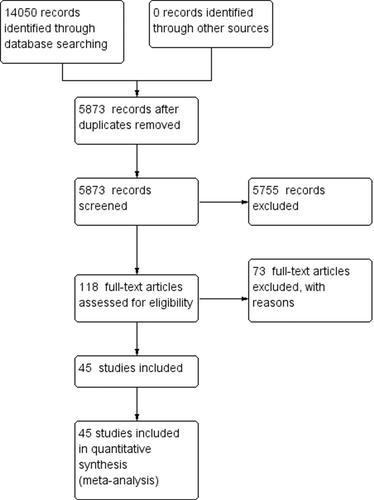翻转课堂对改善本科卫生专业教育学习成果的影响:一项系统综述
摘要
“翻转课堂”方法是教育交付系统中的一种创新方法。在典型的翻转课堂模式中,教学模式中通常作为家庭作业的工作在老师的指导下在课堂上进行互动,而听讲座或观看与课程相关的视频则在家中进行。翻转课堂的本质是将传统课堂时间和自学时间进行的活动颠倒或“翻转”。目的本研究的主要目的是评估翻转课堂干预对卫生专业本科学生学习成绩和课程满意度的影响。我们通过检索MEDLINE (Ovid)、APA PsycINFO、教育资源信息中心(ERIC)以及其他一些电子数据库、注册表、搜索引擎、网站和在线目录来确定相关研究。最后一次搜索更新是在2022年4月。纳入的研究必须满足以下标准:参与者:本科卫生专业学生,无论医疗保健流的类型(如医学、药学)、学习活动的持续时间或学习的国家。干预:我们纳入了所有教育干预,包括将翻转课堂作为本科课程的教学工具,无论医疗保健流的类型(例如,医学,药学)。我们还纳入了旨在提高学生学习和/或学生满意度的研究,如果他们包括本科生的翻转课堂。我们排除了关于标准讲座和后续教程格式的研究。我们还排除了关于翻转课堂方法的研究,这些研究不属于卫生专业教育(HPE)部门(如工程、经济学)。结果:纳入的研究使用了主要结果,如通过期末考试成绩/分数或直接后测的其他正式评估方法来判断的学习成绩,以及学生对学习方法的满意度。研究设计:我们包括随机对照试验(RCTs)、准实验研究(QES)和两组比较设计。虽然我们计划纳入集群水平的随机对照试验、自然实验和回归不连续设计,但这些都无法获得。我们没有包括定性研究。数据收集和分析两名评审小组成员独立筛选检索结果,以评估文章是否符合纳入条件。筛选包括对标题和摘要的初步筛选,随后对选定文章的全文进行筛选。两位研究者之间的差异通过与第三作者讨论或协商解决。审查小组的两名成员随后从纳入的研究中提取描述和数据。我们发现5873条可能相关的记录,其中118条纳入全文筛选,纳入45项符合纳入标准的研究(11项rct、19项QES和15项两组观察性研究)。一些研究评估了不止一种结果。我们在meta分析中纳入了44项关于学习成绩的研究和8项关于学生满意度结果的研究。排除研究的主要原因是他们没有实施翻转课堂方法或参与者不是卫生专业教育的本科生。共有8426名本科生被纳入45项研究,这些研究被确定用于本分析。大多数研究由医学院(53.3%,24/45)、护理学院(17.8%,8/45)和药学院(15.6%,7/45)的学生进行。医学、护理和牙科学校(2.2%,1/45)和其他卫生专业教育项目(11.1%,5/45)。在这45项研究中,16项(35.6%)研究在美国进行,6项研究在中国进行,4项研究在台湾进行,3项研究在印度进行,澳大利亚和加拿大各2项研究,其次是9项单独研究,分别来自巴西、德国、伊朗、挪威、韩国、西班牙、英国、沙特阿拉伯和土耳其。根据总体平均效应量,翻转课堂学习方法的学习成绩优于传统课堂学习(标准化平均差[SMD] = 0.57, 95%置信区间[CI] = 0.25至0)。 90, τ2: 1.16;I2: 98%;P < 0.00001, 44项研究,n = 7813)。在一项敏感性分析中,排除了11项研究的44项研究的原始分析数据,翻转课堂学习方法的学习成绩优于传统课堂学习(SMD = 0.54, 95% CI = 0.24 ~ 0.85, ρ 2: 0.76;I2: 97%;P < 0.00001, 33项研究,n = 5924);所有证据的确定性都很低。总体而言,与传统课堂学习相比,学生对翻转课堂学习的满意度为正(SMD = 0.48, 95% CI = 0.15至0.82,τ2: 0.19, I2:89%, p < 0.00001, 8项研究n = 1696);所有证据的确定性都很低。作者结论在本综述中,我们旨在寻找翻转课堂干预对本科卫生专业学生有效性的证据。我们只发现了少数随机对照试验,纳入的非随机研究的偏倚风险很高。总体而言,实施翻转课堂可以提高学习成绩,并可能支持学生对本科健康专业课程的满意度。然而,与传统的课堂学习相比,翻转学习方法的学习成绩和学生满意度的证据确定性都较低。未来需要设计良好、功率充足、低偏倚风险的随机对照试验,并根据CONSORT指南进行报告。

Background
The ‘flipped classroom’ approach is an innovative approach in educational delivery systems. In a typical flipped class model, work that is typically done as homework in the didactic model is interactively undertaken in the class with the guidance of the teacher, whereas listening to a lecture or watching course-related videos is undertaken at home. The essence of a flipped classroom is that the activities carried out during traditional class time and self-study time are reversed or ‘flipped’.
Objectives
The primary objectives of this review were to assess the effectiveness of the flipped classroom intervention for undergraduate health professional students on their academic performance, and their course satisfaction.
Search Methods
We identified relevant studies by searching MEDLINE (Ovid), APA PsycINFO, Education Resources Information Center (ERIC) as well as several more electronic databases, registries, search engines, websites, and online directories. The last search update was performed in April 2022.
Selection Criteria
Included studies had to meet the following criteria: Participants: Undergraduate health professional students, regardless of the type of healthcare streams (e.g., medicine, pharmacy), duration of the learning activity, or the country of study. Intervention: We included any educational intervention that included the flipped classroom as a teaching and learning tool in undergraduate programs, regardless of the type of healthcare streams (e.g., medicine, pharmacy). We also included studies that aimed to improve student learning and/or student satisfaction if they included the flipped classroom for undergraduate students. We excluded studies on standard lectures and subsequent tutorial formats. We also excluded studies on flipped classroom methods, which did not belong to the health professional education(HPE) sector (e.g., engineering, economics). Outcomes: The included studies used primary outcomes such as academic performance as judged by final examination grades/scores or other formal assessment methods at the immediate post-test, as well as student satisfaction with the method of learning. Study design: We included randomised controlled trials (RCTs), quasi-experimental studies (QES), and two-group comparison designs. Although we had planned to include cluster-level RCTs, natural experiments, and regression discontinuity designs, these were not available. We did not include qualitative research.
Data Collection and Analysis
Two members of the review team independently screened the search results to assess articles for their eligibility for inclusion. The screening involved an initial screening of the title and abstracts, and subsequently, the full text of selected articles. Discrepancies between the two investigators were settled through discussion or consultation with a third author. Two members of the review team then extracted the descriptions and data from the included studies.
Main Results
We found 5873 potentially relevant records, of which we screened 118 of them in full text, and included 45 studies (11 RCTs, 19 QES, and 15 two-group observational studies) that met the inclusion criteria. Some studies assessed more than one outcome. We included 44 studies on academic performance and eight studies on students' satisfaction outcomes in the meta-analysis. The main reasons for excluding studies were that they had not implemented a flipped class approach or the participants were not undergraduate students in health professional education. A total of 8426 undergraduate students were included in 45 studies that were identified for this analysis. The majority of the studies were conducted by students from medical schools (53.3%, 24/45), nursing schools (17.8%, 8/45), pharmacy schools (15.6%, 7/45). medical, nursing, and dentistry schools (2.2%, 1/45), and other health professional education programs (11.1%, 5/45). Among these 45 studies identified, 16 (35.6%) were conducted in the United States, six studies in China, four studies in Taiwan, three in India, two studies each in Australia and Canada, followed by nine single studies from Brazil, German, Iran, Norway, South Korea, Spain, the United Kingdom, Saudi Arabia, and Turkey. Based on overall average effect sizes, there was better academic performance in the flipped class method of learning compared to traditional class learning (standardised mean difference [SMD] = 0.57, 95% confidence interval [CI] = 0.25 to 0.90, τ2: 1.16; I2: 98%; p < 0.00001, 44 studies, n = 7813). In a sensitivity analysis that excluded eleven studies with imputed data from the original analysis of 44 studies, academic performance in the flipped class method of learning was better than traditional class learning (SMD = 0.54, 95% CI = 0.24 to 0.85, τ2: 0.76; I2: 97%; p < 0.00001, 33 studies, n = 5924); all being low certainty of evidence. Overall, student satisfaction with flipped class learning was positive compared to traditional class learning (SMD = 0.48, 95% CI = 0.15 to 0.82, τ2: 0.19, I2:89%, p < 0.00001, 8 studies n = 1696); all being low certainty of evidence.
Authors' Conclusions
In this review, we aimed to find evidence of the flipped classroom intervention's effectiveness for undergraduate health professional students. We found only a few RCTs, and the risk of bias in the included non-randomised studies was high. Overall, implementing flipped classes may improve academic performance, and may support student satisfaction in undergraduate health professional programs. However, the certainty of evidence was low for both academic performance and students' satisfaction with the flipped method of learning compared to the traditional class learning. Future well-designed sufficiently powered RCTs with low risk of bias that report according to the CONSORT guidelines are needed.

 求助内容:
求助内容: 应助结果提醒方式:
应助结果提醒方式:


